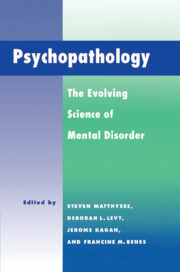Book contents
- Frontmatter
- Contents
- List of Contributors
- Preface
- Brain mechanisms
- Development
- Thinking
- Genetics
- 20 Editors' introduction: Contemporary issues in the genetics of psychopathological disorders
- 21 Genetic and environmental factors in the etiology of schizophrenia
- 22 Problems and paradoxes in research on the etiology of schizophrenia
- Comments on Einar Kringlen's chapter
- 23 Epistemological issues in psychiatric research
- 24 Searching for major genes for schizophrenia
- 25 The Drosophila eye and the genetics of schizophrenia
- Response and reflections
- Author index
- Subject index
23 - Epistemological issues in psychiatric research
Published online by Cambridge University Press: 04 May 2010
- Frontmatter
- Contents
- List of Contributors
- Preface
- Brain mechanisms
- Development
- Thinking
- Genetics
- 20 Editors' introduction: Contemporary issues in the genetics of psychopathological disorders
- 21 Genetic and environmental factors in the etiology of schizophrenia
- 22 Problems and paradoxes in research on the etiology of schizophrenia
- Comments on Einar Kringlen's chapter
- 23 Epistemological issues in psychiatric research
- 24 Searching for major genes for schizophrenia
- 25 The Drosophila eye and the genetics of schizophrenia
- Response and reflections
- Author index
- Subject index
Summary
Introduction
Matthysse and Parnas (1992) demonstrated that studies which only investigate overt schizophrenia as the informative phenotype are bound to result in failures to detect linkage, even if linkage is present. We suggested the use of the spectrum concept of schizophrenia and of putative extraclinical measures, such as eye tracking disorder, in order to enhance the likelihood of detecting existing linkage. The question is how to delimit the range of phenotypes which may be informative in genetic studies of schizophrenia. Many researchers, including the author (Parnas et al., 1993), subscribe to the diathesisstress model of schizophrenic etiology (e.g., Meehl, 1962, 1989), elegantly formulated by Minkowski (1927) half a century ago:
The notion of schizophrenia, as a mental disease, can be decomposed into two factors, of different order: first, the schizoidia, which is a constitutional factor, highly specific, and temporally enduring through the individual life; and, second, a noxious factor, of an evolutional nature, and which has the ability to determine a morbid mental process. This letter factor has, for itself, no definite taint, it is of a more unspecific nature, and the clinical picture to which it will lead will depend upon the ground on which it will act. It will transform schizoidia into a specific morbid process, into schizophrenia, (pp. 50–51, my translation, my emphasis).
- Type
- Chapter
- Information
- PsychopathologyThe Evolving Science of Mental Disorder, pp. 511 - 538Publisher: Cambridge University PressPrint publication year: 1996



